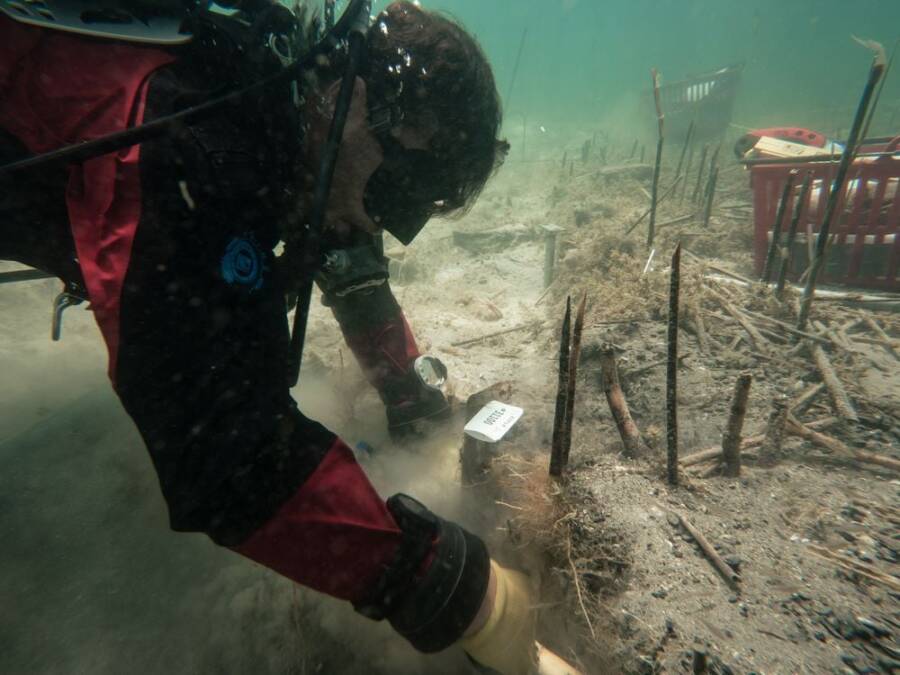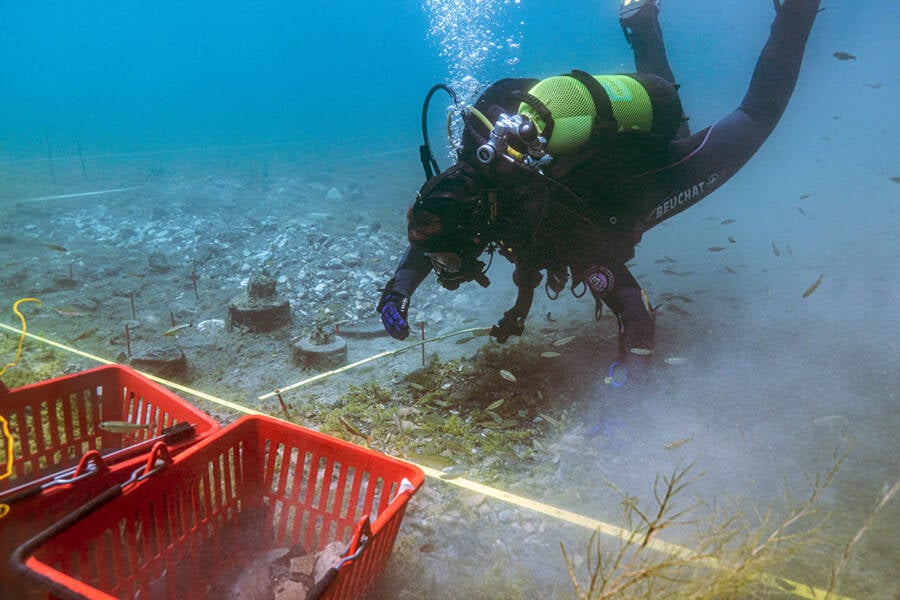Archaeologists said the settlement could be the "missing link" in mapping similar lakeside villages to understand the development of agriculture in the region.

Nikolas Linke/University of BernThousands of stilts that once held up the Neolithic village were discovered submerged in the lake.
A team of Swiss and Albanian archaeologists recently uncovered what is likely the oldest-known lakeside village in Europe — and it was built on stilts.
Believed to be around 8,000 years old, the village is submerged in the waters of Lake Ohrid on the border of Albania and North Macedonia, near the Albanian village of Lin. Preliminary radiocarbon dating estimates the remnants of the settlement are from between 6,000 and 5,800 B.C.E., and archaeologists estimate the it was home to between 200 and 500 people.
Houses were built on tree trunk stilts over the lake, and the team of archaeologists found tens of thousands of spiked planks that likely served as a defense mechanism for the village, though why the villagers would need such defenses is still somewhat of a mystery.
“Building their village on stilts was a complex task, very complicated, very difficult, and it’s important to understand why these people made this choice,” Adrian Anastasi, an Albanian archaeologist on the team, told AFP.
Lead archaeologist Albert Hafner, from the University of Bern in Switzerland, said the stilt houses and spiked planks indicate the village was likely often attacked.
Hafner and his team have carried out half a dozen other excavations in the Balkan region, but the lakeside village on Lake Ohrid is by far the oldest one discovered. Similar sites in the Italian Alps and across Eastern Europe were previously the oldest known lakeside settlements, but the Lake Ohrid site likely predates those by several hundred years.
Due to its position on the lake, as well as the seeds, plants, and animal bones found on site, archaeologists believe the village relied on agriculture and domesticated livestock. According to an interview with the Switzerland Federal Department of Foreign Affairs, Hafner said the ancient village was likely a hub for the westward movement of fishing, craftsmanship, and agriculture in Europe.
Hafner has led the EXPLO project, short for “exploring the dynamics and causes of prehistoric land use change in the cradle of European farming”, since 2019. The EXPLO team, made up of researchers from the University of Bern, the University of Oxford, and the University of Thessaloniki, is conducting research into how farming and agricultural practices made their way from Asia into Eastern Europe an estimated 8,000 years ago — right around the estimated timeframe of this new village.

Marco Hostettler/University of BernA diver excavates material in Ploča Michovgrad, Lake Ohrid, North Macedonia.
The EU’s European Research Council funds the project, and the excavations use techniques like radiocarbon dating and dendrochronology — studying tree rings to determine growth — to estimate the age of settlements.
The EXPLO team has published multiple studies on ancient settlements in the Balkan region. According to the most recent study from June of this year, Lake Ohrid is possibly the oldest lake in Europe, and before the discovery of the Lin site on the Albanian side of the lake, Ohridati on the North Macedonian side was the oldest known settlement on Lake Ohrid, dating back to around 5500 B.C.E. At the time of the June study, there were more than 10 known settlements on Lake Ohrid and around 1,000 sites in the Balkan region.
The village is the final stage of the EXPLO project after the team’s previous discoveries in Greece and North Macedonia, and Hafner said he hopes it will be the “missing link” to connect all the sites.
“The project as a whole aims to better understand human-environment interactions of early agrarian societies,” Hafner said. “How did people use the land back then, why did they settle here and how did they deal with crises? Actually, these are the same questions we ask ourselves today. We also want to show what great developmental steps mankind has made in just a few thousand years.”
After reading about the oldest lakeside village in Europe, read about the oldest evidence of dysentery found in 2,500-year-old poop. Or read about the oldest human footprints ever found.





